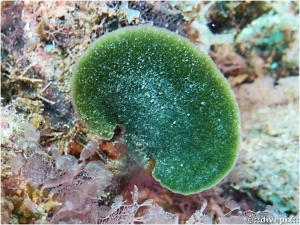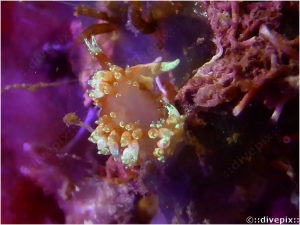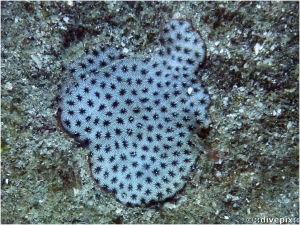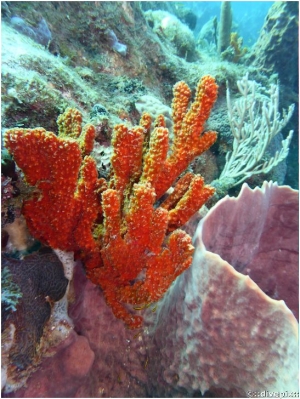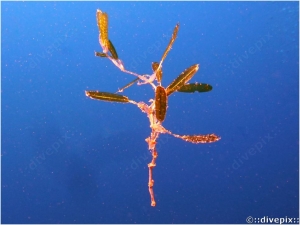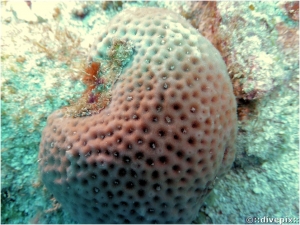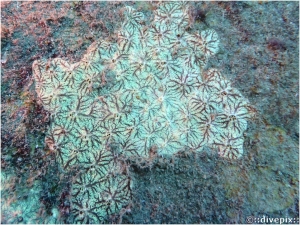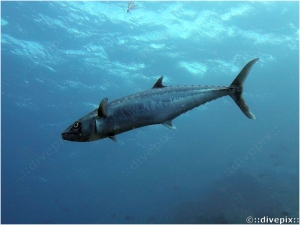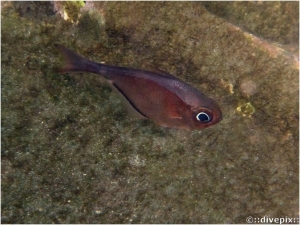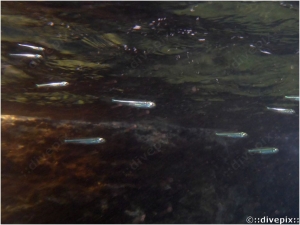




Eric H. Biass
Paddle Blade Alga
| Aspect: | Looks like a green miniature ping-pong racket, with velvety surface. |
| Population: | Occasional. |
| Notable feature: | - |
| Environment: | Occurs in relatively shallow sandy areas. |
| Behaviour: | - |
Long-horn Nudibranch
| Aspect: | Two large forward white horn-shaped tentacles each sporting one brown band together with shorter intermediate horns head a brownish elongated body of gelatinous aspect, which in turn carries several sets of complex whitish growths called cerata that constitute the "breathing" apparatus of the animal. |
| Population: | Actually reasonably abundant. |
| Notable feature: | To the regular diver around Ilets Pigeon, the above comment may cause total disbelief. The truth is that the species is extremely small and very well camouflaged, but as the photographs below unequivocally prove, the use of an ultraviolet torch immediately betrays their presence. While they were all taken around the same diving site, these pictures actually show four different specimens. |
| Environment: | Divepix will carry out further in situ investigations to better determine the habitat of this tiny animal. |
| Behaviour: | Relies on deception to avoid detection and thus ignores a diver's presence. |
Lesser Starlet Coral
| Aspect: |
Flat encrusting formation of small, deep-cored corallites. |
| Population: | Common. |
| Notable feature: |
Colour usually grey-blue. |
| Environment: | Found at depths of a few metres to 15 or 20 metres. |
| Behaviour: | Polyps extend at night. |
Red-Orange Branching Sponge sp.,
Aspect:
|
Bright orange to red-orange odd-branching cylidrical structures featuring lighter edged blades. Remark: The species seen here has not been formally identified but given its deeper scarlet colour and spinous skin, is probably of the Ptilocaulis walpersii variety. |
|
| Population: | Uncommon, without being rare, |
| Notable feature: | Rough surface, somewhat reminiscent of a pineapple. |
| Environment: | Rocky substrate. |
| Behaviour: | - |
Halophila Sea Grass
| Aspect: | Elongated green blades the stalks of which are directly attached to the rhizomes. |
| Population: | Common on the sandy seabeds surrounding Ilets Pigeon. Halophila stipulacea or baillonis are the probable varities seen in the area (there are hundreds of Hlaphilia varietes). |
| Notable feature: | Floating in mid-water after a storm probably is the way most divers around Ilets Pigeon will encounter this sea weed, which otherwise rests on sandy bottoms with only the leaves (or blades) protruding, the rhizome system remaining neatly tucked away from sight. |
| Environment: | Usually found on large sandy bottoms down to 30 metres, which often serve as pastures to Green Turtles. |
| Behaviour: | . |
Massive Starlet Coral
| Aspect: | Appears as a light brown, or brown, solid boulder-shaped mass of tight, small and deeply pitted corallites. |
| Population: | Common. |
| Notable feature: | Corallites are relatively small, funnel shaped, and bordered by some 28 septa, the outer edges of which (the costae) penetrate those of a neighbouring polyp septa array in a manner reminiscent of cogworks. |
| Environment: | Relatively shetered areas at depths of between 3 and 20 metres. |
| Behaviour: | - |
White Encrusting Clathria sp. (non official)
| Aspect: |
A relatively thin, white-ish encrusting mass, with darker veinous canals radiating from low conical excurrent openings. This apparently undescribed species is assumed to be a form of Clathria demonspongia due to its general visual aspect. |
| Population: | Uncommon. |
| Notable feature: |
Unlike other Clathria like White Encrusting Sponge (q.v) and Peach Encrusting Sponge (q.v.), this specimen features darker radiating canals rather than white ones. Note: Due to its clear repeated star patterns, this specimen could be mistaken for a Star Encrusting Sponge (q.v.). However, one of the features of the latter type is its relatively independent network of branching canals that seldom connect with that of a neighbouring network. |
| Environment: | This unusual sample was photographed on the metal roof of a shipwreck, the Ausgustin Fresnel, at a depth of about 20 metres. |
| Behaviour: | - |
King Mackerel
| Aspect: | Sleek and elongate plain silver body, with matching elongated head. Serrated spine and rear "keel" aft dorsal and anal fins. |
| Population: | Common, but often mistaken for Cero (q.v.). |
| Notable feature: | Looks very much like a Cero (though it can be larger), but is totally devoid of lateral spots. High lateral line abruptly kinks downwards at mid-body length to continue in a centreline position towards the tail. |
| Environment: | Open waters. |
| Behaviour: | Not too wary, but like Cero will swimm away after a short while. |
Glassy Sweeper, or Hatchetfish
| Aspect: | Compressed brown-copper body with deep-v belly profile. Also known as Hatchefish (as in French) due to its shape. |
| Population: | Occasional. |
| Notable feature: |
Black line along base of almost translucent anal fin. |
| Environment: | Rock-protected unexposed areas. |
| Behaviour: | - |
Anchovy
| Aspect: | Slender silvery oblong shaped, with small narrow-forked tail. |
| Population: | Common. |
| Notable feature: | Narrow forked tail. There are more than a hundred sub-species in this group, identification thus requires taking a specimen out of the water. |
| Environment: | Lives in schools, in sheltered shallow waters . |
| Behaviour: | Constantly moves away when approached. Difficult to photograph. |



